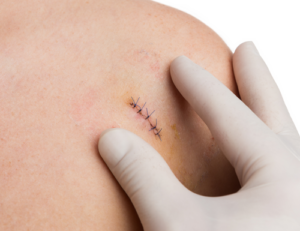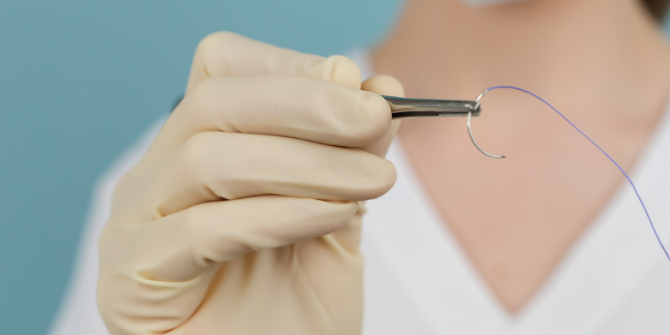Does Urgent Care Do Stitches?
While not always expected, accidents and injuries happen every day. It’s common for people to administer first-aid, apply bandages, and care for minor wounds at home. However, large cuts and deep lacerations require additional medical attention beyond what can be provided at home.
If you or a loved one are dealing with cuts and scrapes and are concerned about wound management, among the many concerns that may cross your mind are: Do you need stitches, and Does urgent care do stitches?
We at Solar Urgent Care want you to know that cuts and scrapes are common and, in most cases, are generally no cause for alarm. Because many are unaware that they can head to their nearest urgent care instead of the emergency room or their physician’s office for treatment, we’ve put together the following information on urgent care and stitches.
It’s critical for you to know how to identify whether your injuries, especially open wounds or lacerations, require stitches so you can get the timely medical intervention you need to prevent infection and healing impairments. Here are some questions and answers to help you determine if a trip to Solar Urgent Care for stitches is in order.
How do I know if I need stitches?
If you’re unsure whether you need stitches, your best bet is to visit our urgent care for a professional wound assessment to learn treatment recommendations. In the meantime, consider the info below to determine whether your injury requires urgent care or stitches.
How badly is the cut bleeding?
Cuts vary in severity and depth. Pain is often an indicator of wound severity and is usually more acute with severe injuries. But not always. Pain is subjective and varies per person. You may have a higher pain tolerance than someone with a similar wound. Also, it’s not easy to determine how deep a cut is, which is a good reason to have a doctor check your injuries.
Shallow cuts or scrapes that may or may not bleed can be safely treated at home. However, injuries that bleed profusely or gush blood cannot. If your cut or laceration is soaking through bandages or does not stop after applying light to mild pressure for 10 to 15 minutes.
Then you need to see a doctor to care for the wound and administer stitches, if necessary. Do not procrastinate or delay your decision to go to urgent care. Blood loss can be dangerous, depending on the severity and location of the wound.
How did the injury happen?
Cuts and scrapes can happen anywhere on the body by practically anything. Sure, paper cuts are annoying and bothersome, but they eventually heal on their own. But that’s not always the case with larger or deeper cuts, scrapes, or wounds. That’s why it’s helpful to consider the cause of the injury.
Suppose you are in the kitchen, chopping up vegetables for a salad with a large knife and you accidentally cut your finger. Or, what if you step on a rusty nail on your garage floor? What if an animal attacks you, or you end up in a physical altercation, or suffer a sports injury? These types of wounds can be dangerous to manage without proper medical care. And while they often range from mild to severe, medication and stitches may be required to minimize your infection risks.
Where is the injury located on your body?

Large or deep cuts and wounds can be fatal, and so can small or minor injuries that seep or gush blood, regardless of where they occur on your body. Complications like nerve damage, infection, and longer healing times are common without proper medical care to stop the severed tissues and vessels from bleeding.
What are the signs of infection?
With wounds and injuries that break the skin and damage the tissues and nerves underneath, there is always the possibility of infection. Some of the most common signs include:
- Fever
- Redness at the injury site
- Swelling
- Pain and tenderness
- Pus or fluid seepage
Medical attention provides an opportunity to have the wound properly assessed, so antibiotics and medications, along with proper treatment, can be administered quickly to minimize any infection risks or complications. In cases where an infection is present, medical treatment stops it in its tracks so the wound can begin to heal properly.
Although many wounds and injuries heal independently, stitches can help shorten the time it takes for them to mend. Sutures are necessary for certain types of wounds, including large or deep cuts, scrapes, and lacerations, to reduce scarring, impairment, and infections.
What to do if I suspect I need stitches?
If you’re unsure if you need stitches, perform the following steps to get a better idea of how serious your wound may be.
- Clean the injury as best as you can with water.
- Apply firm pressure for at least 10 to 15 minutes to stop any bleeding.
- Visually inspect the wound to determine if there’s a noticeable gap or separation of ½ inch or larger between the damaged skin layers.
If your injury has dirt, debris, or foreign objects stuck inside or is located on the face, arm, knee joints, genital area, hands, or feet, you may need stitches. A doctor should look at any injury or bite attack (human or animal) that breaks the skin to prevent infection. Also, if you have a weak immune system, autoimmune disorders, diabetes, or vascular issues, you should stop by our urgent care to get proper medical attention to be safe.
Solar Urgent Care provides complete care and stitches for most wounds and injuries, including cuts and lacerations.
Call our Oxnard urgent care clinic at (805) 988-9000 for more information on our medical services.








